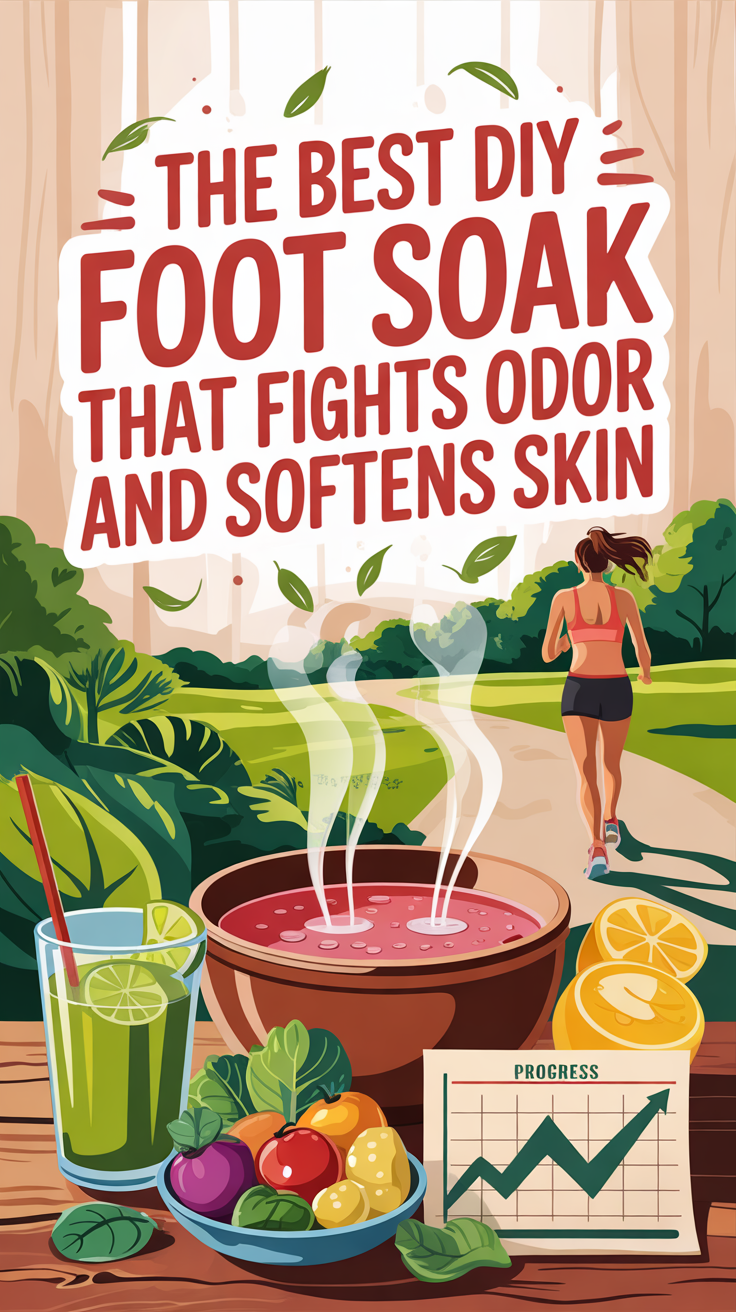The Best DIY Foot Soak That Fights Odor and Softens Skin
To create the best DIY foot soak that fights odor and softens skin, mix 1 cup of Listerine, 1 cup of white vinegar, and 2 cups of warm water in a basin. Add half a cup of Epsom salt and optional tea tree or peppermint essential oils for extra freshness. Soak your feet for 15-30 minutes to relax and exfoliate. This simple ritual not only tackles odor but also rejuvenates your skin. Discover how to enhance your results further!
Understanding Foot Odor and Its Causes
Foot odor is a common issue that many people face, and understanding its causes can help you tackle it effectively.
You produce sweat daily, and when bacteria break it down, they create unpleasant odors. This problem worsens with poor hygiene, reusing damp shoes, and certain conditions like hyperhidrosis. Managing fungal infections can also play a significant role in reducing foot odor. Additionally, the antimicrobial ingredients in Listerine can help combat the bacteria responsible for foot odor.
Hormonal changes and stress can also increase sweating, leading to even more odor. To combat this, consider using a Listerine foot soak, which can help eliminate bacteria.
Key Ingredients for an Effective Foot Soak
When crafting an effective foot soak, key ingredients can work wonders for your feet. Antifungal properties help combat odors, while balancing pH ensures a healthier environment for your skin. Additionally, using Epsom salt in your soak can enhance relaxation and relieve foot pain. Plus, skin-softening agents will leave your feet feeling rejuvenated and smooth. To further enhance your soak, consider incorporating antifungal properties to treat and prevent athlete’s foot and toenail fungus.
Antifungal Properties Explained
Creating an effective antifungal foot soak involves harnessing the power of key ingredients known for their antifungal properties.
Vinegar acts as a warrior against fungal infections, while eucalyptus-infused Listerine boosts your soak with menthol and thymol. Vinegar’s acetic acid possesses antifungal properties that may slow growth of certain foot fungi and skin infections. Add a few drops of tea tree oil to target stubborn fungi like Trichophyton rubrum. Epsom salt, while not antifungal directly, soothes and softens skin. Baking soda shows antifungal potential in studies, too.
Mixing these ingredients creates an optimal environment that fights fungus and promotes healthy skin. Regular use can ward off future infections, keeping your feet fresh and fungus-free!
Ph Balance Benefits
A well-balanced pH in your foot soak can significantly enhance its effectiveness, making your feet feel refreshed and rejuvenated. Keeping the pH between 7.35-7.45 helps maintain your skin’s natural barrier and prevents irritation. A pH-balanced soak allows for better absorption of beneficial ingredients, ensuring your skin stays hydrated. Incorporating ingredients like urea, glycerin, and soothing herbs contributes to this balance. Plus, a balanced soak offers microbial protection, essential for healthier skin. This is particularly effective when enriched with Urea, which aids in smoothing rough areas while helping to maintain the skin’s moisture barrier.
Skin Softening Ingredients
Soft, smooth feet are within reach with the right skin softening ingredients in your foot soak. Natural moisturizers like bananas and avocados provide hydration, while Epsom salts enhance absorption so your skin drinks up the good stuff. Incorporate jojoba oil for an added softening effect, and vinegar to help remove dead skin. Regular moisturizing is essential—don’t forget honey—it acts as a humectant, drawing moisture in! You can also enrich your soak with essential oils like tea tree for soothing and lemon for a refreshing kick. Combine these ingredients for an effective foot soak that leaves your feet feeling soft and revitalized.
Step-by-Step Guide to Making the DIY Foot Soak
To create your DIY foot soak, you’ll first need to gather all your ingredients for a relaxing experience. Next, prepare your foot soak by mixing the components in warm water, ensuring everything’s well combined. Finally, soak your feet and enjoy the numerous benefits that come with this simple yet effective self-care ritual, including the antimicrobial and pain-relieving properties that help soothe tired feet.
Gather Your Ingredients
Gathering your ingredients for a DIY foot soak is the first step toward pampering your tired feet effectively.
Start with Epsom salt for its soothing properties, then mix in sea salt for added benefits.
Don’t forget the essential oils; peppermint, tea tree, and sweet orange create a refreshing and therapeutic experience.
Add baking soda to balance pH and soften the skin.
For antimicrobial properties, include olive leaf extract or lemon juice.
Finally, if you want extra hydration, consider honey or coconut oil for that luxurious touch.
Having these ingredients ready will set the stage for a rejuvenating soak!
Prepare Foot Soak
Ready to indulge your feet? Start by filling a basin with warm water.
Next, add Epsom or sea salt for that soothing effect.
Toss in your favorite essential oils—tea tree for antimicrobial power, or peppermint for a refreshing vibe.
Sprinkle in some baking soda to neutralize any odors.
Give the mixture a good stir to dissolve everything completely.
For specific needs, feel free to adjust ingredients, like adding apple cider vinegar for odor control.
Once you’ve prepared your foot soak, you’re ready for a relaxing experience that pamper your feet and leaves them smelling fresh!
Enjoy the Benefits
Now that you’ve prepared your foot soak, it’s time to enjoy the numerous benefits that come from this simple and effective self-care ritual.
Immerse your feet in warm water for 15-20 minutes to experience stress reduction, muscle relief, and improved circulation.
Add Epsom salts for inflammation relief and essential oils like tea tree to combat odor.
Exfoliate with baking soda or pumice stones to remove dead skin.
After soaking, pat your feet dry, and apply a rich moisturizer like shea butter to lock in hydration.
This thoughtful routine leaves your feet refreshed, soft, and odor-free. Enjoy the pampering!
Additional Benefits of the Foot Soak
Soaking your feet isn’t just a treat for tired soles; it can also provide a myriad of additional benefits that enhance your overall well-being.
The warm water relaxes your muscles, reducing tension and promoting calmness, so you can feel stress melt away.
Increased circulation boosts blood flow, which can alleviate pain and swelling, especially if you’ve been on your feet all day.
Plus, the soak softens and exfoliates your skin, leaving it smooth and hydrated.
Combining ingredients like Epsom salt and essential oils can help detoxify and combat odor, creating a holistic foot care experience you’ll love. Additionally, the osmosis effect of Epsom salt can draw excess fluid from tissues, further helping with swelling.
Tips for Maximizing Results
Unlocking the full benefits of your foot soak requires a few simple tweaks to your routine.
First, ensure the water temperature is between 92°F and 100°F for optimal relaxation.
Use a clean container to maintain hygiene and add half a cup of Epsom salt to relax muscles.
Soak your feet for at least 15-30 minutes, and consider enriching the water with peppermint or tea tree essential oils for added freshness and odor-fighting power.
Create a cozy atmosphere by dimming the lights, playing calming music, and minimizing distractions.
Regularly soaking your feet can enhance results, so make it a weekly ritual! Consistent soaks not only provide softer feet but can also help address fungal issues over time.
Aftercare: Hydrating and Protecting Your Feet
While your foot soak provides a fantastic start to foot care, effective aftercare is essential for maintaining soft, healthy feet.
Daily moisturizing with creams containing shea butter or glycerin keeps skin hydrated and prevents cracking. Additionally, incorporating natural antimicrobials into your foot care routine can help reduce the risk of infections and further improve skin health.
Avoid over-moisturizing between your toes to sidestep infections. Choose breathable socks that wick moisture and wash your feet daily to uphold hygiene. Don’t forget to dry thoroughly between your toes and use antifungal powders if needed. To enhance hydration, consider wearing moisturizing socks after applying lotion.
With these steps, you’ll enjoy fresher, softer feet all day long.

